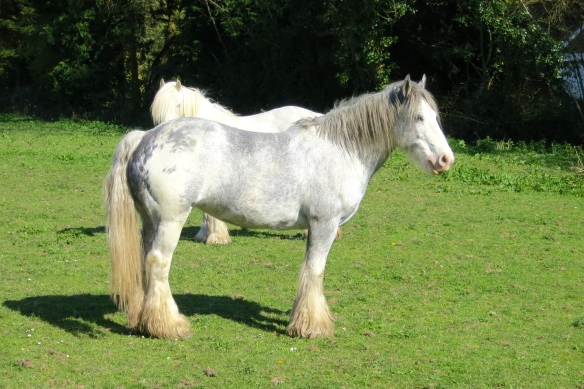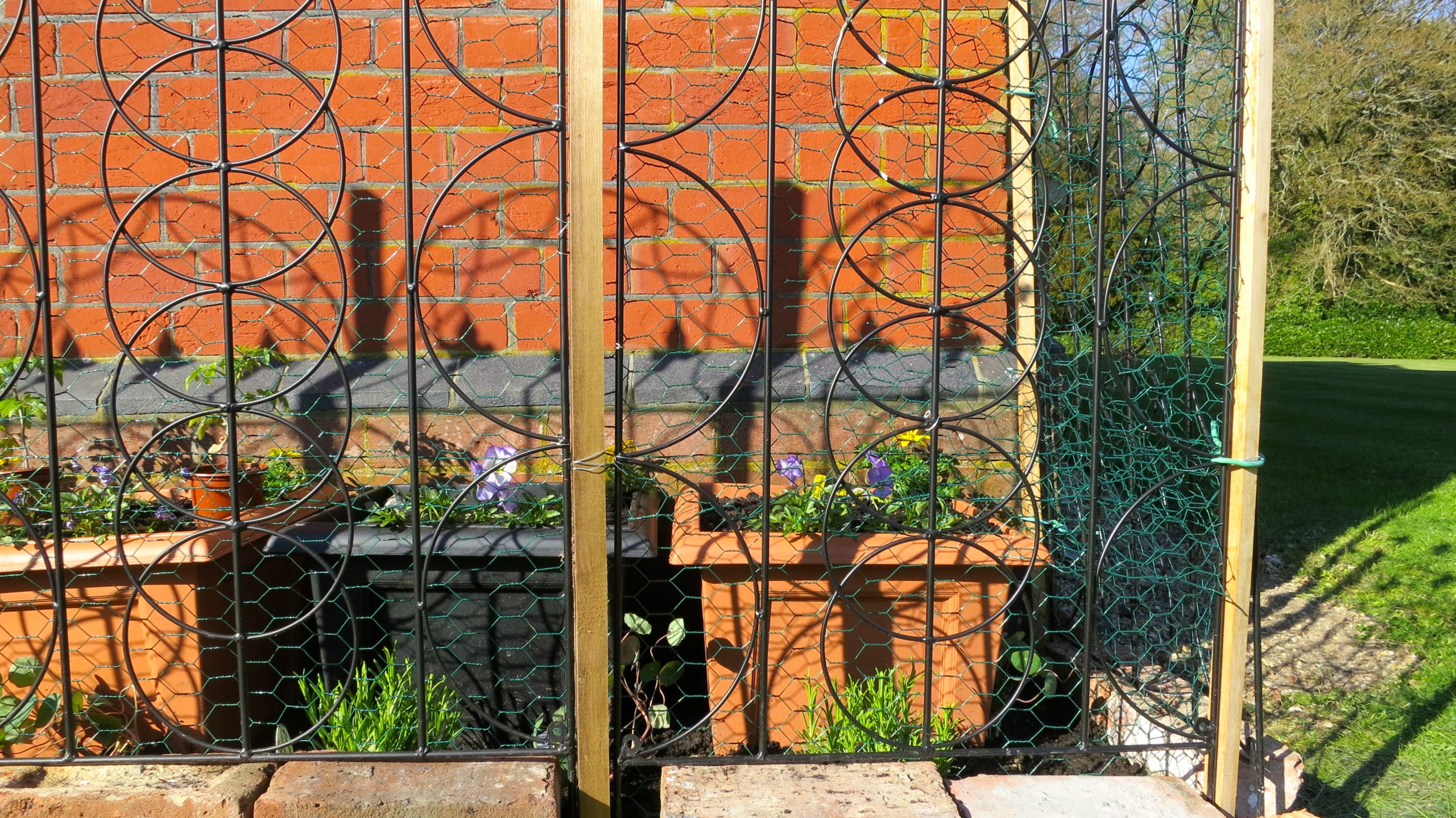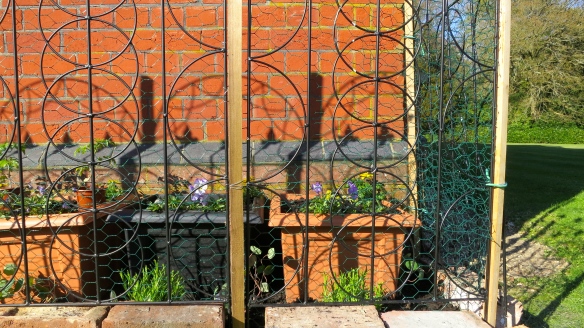 As I dug out the trench this morning for Jackie’s protective netting, and she was planting seedlings in pots, I noticed that blossom has indeed come to the Lodge garden. By mid afternoon the sun has always moved across to the other side of the garden.
As I dug out the trench this morning for Jackie’s protective netting, and she was planting seedlings in pots, I noticed that blossom has indeed come to the Lodge garden. By mid afternoon the sun has always moved across to the other side of the garden. Today John’s lawn mowing looked splendid in its light. The natural landscaping, presenting different sweeping levels, with a distinct slope down to the East, reminds us that the building occupies the site of an Iron Age hill fort. Unfortunately my enjoyment of the sunshine was somewhat curtailed by my spending much of the day on administration, too boring to record, most of which should have been done months ago. I just managed to get to the village shop in time to post ten letters and collect my dry cleaning.
Today John’s lawn mowing looked splendid in its light. The natural landscaping, presenting different sweeping levels, with a distinct slope down to the East, reminds us that the building occupies the site of an Iron Age hill fort. Unfortunately my enjoyment of the sunshine was somewhat curtailed by my spending much of the day on administration, too boring to record, most of which should have been done months ago. I just managed to get to the village shop in time to post ten letters and collect my dry cleaning.
It was still a glorious day. The slow clip-clop of the wild ponies’ hooves as they strolled down and across the road, their haunches undulating awkwardly and their heads imitating car drivers’ nodding dogs, was almost all the sound I heard. There was also the occasionally purring of the engine of a car brought to a standstill when one or all of the animals decided to take a diagonal amble. When they are headed straight for you it is still a bit disconcerting. It is best to convince yourself they are not going to bite you.  A snorting I heard came from two magnificent farm horses, which must be a particular breed, now occupying a field across the road from Minstead Hall. I don’t think the ponies have the energy for blowing air through their noses. By the time I returned home, Jackie had almost completed her little garden fence.
A snorting I heard came from two magnificent farm horses, which must be a particular breed, now occupying a field across the road from Minstead Hall. I don’t think the ponies have the energy for blowing air through their noses. By the time I returned home, Jackie had almost completed her little garden fence.
When preparing the ground for this rabbit and deer proof structure, I was thinking of ‘Rabbit-Proof Fence’. This is a marvellous Australian film drama from 2002 directed by Philip Noyce, adapted from ‘Follow the rabbit-proof fence’, the book by Doris Pilkington Garimara. It tells the story of the author’s mother and two other dual heritage Aboriginal girls who ran away from Moore River Native Settlement situated to the north of Perth, Western Australia, where they had been forcibly placed in 1931. They knew that if they followed the 1,500 mile (2,400 km) fence it would take them to their families in their homes in Jigalong. They covered this ground in nine weeks, all the while being pursued by a white authority figure and an Aboriginal tracker.
It is some years since I saw this film, but it is not one I am likely to forget. The terribly mistaken policy that separated so many families; the cruelty to which the children were subjected; the pain of the bereft parents; and the magnificent fortitude shown by the escapees burns in one’s memory like the searing heat which they endured.
 The tasteful symphony in white and cream with an intro of orange that Jackie served up for our evening meal was smoked haddock, cauliflower cheese (recipe), mashed potatoes, and carrots. Accompanied by a 2012 Bordeaux sauvignon blanc, it was followed by a delicious plum crumble.
The tasteful symphony in white and cream with an intro of orange that Jackie served up for our evening meal was smoked haddock, cauliflower cheese (recipe), mashed potatoes, and carrots. Accompanied by a 2012 Bordeaux sauvignon blanc, it was followed by a delicious plum crumble.


That looks a beautiful part of the world. I Googled Minstead Hall and came up with it in Hampshire, west of Southampton? Strange to think of having wild horses there. I was thinking of blogging about an Aussie documentary I saw last week, about catching wild horses, brumbies, and relocating them. I was so glad to see that Rabbit Proof Fence resonated with you. It was a powerful film, but we can never be sure how well the Aussie voice travels. Removing children from Aboriginal families for assimilation was an incredible policy that persisted well into the 60s. In fact, there is a scene in my book referring to it. Hard to believe isn’t it?
That is the location of Minstead. Actually our flat was in Castle Malwood Lodge, which is what is pictured. Our daughter Becky commented on this post on the Facebook link that she had also enjoyed the film, and she has never been to Australia. In a rather different treatment the Aboriginal children story crops up again in the film Australia, which I assume you also know.
Ah yes, Australia. I wasn’t sure if we were meant to take that film seriously. Nicole Kidman seemed to be treating it as a farce, at least in the beginning, but I know what you mean about the Aboriginal reference. You might also want to look out for The Sapphires. Set in the 60s, it shows the prejudice shown to four Australian Aboriginal singer performers in their country town, and then they go off to be performers in the Vietnam War. Another true story. Another classic is The Chant of Jimmie Blacksmith, originally a book by Thomas Keneally. – Pretty part of the world you live in.
Australia was eye candy. Will look out for your recommendations. Thank you
Yes, the early settlers here treated the aboriginals worse than animals, especially in Western Australia, the last frontier. They weren’t even counted as human beings in the census before 1967!